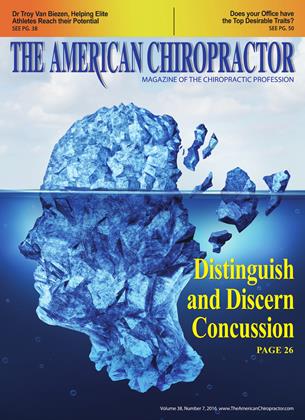A Question of Balance
HEALTH
CARE
Richard G. Barwell
DC
The Moody Blues had it right! It really is about balance, and this pertains to how both the body and the chiropractic profession stay healthy.
The Body
The job of “innate intelligence” in the body is all about survival value. In the past, we have talked about homeostasis, which is about balance within the systems. The new understanding of this phenomenon recognizes that this balance is not static but rather a moving group of responses that shifts, depending on the changes in environmental events. The term now used is “allostasis,” or adaptive balance. However, there is an ideal balance within these shifts as the body attempts to adapt to external stressors. Problems start when the external events overload the processing resources of the control center. The organizing authority of the body, the brain, does have processing limits and once these aie exceeded, the brain literally begins to build short-term patch responses that fail to return to the ideal balance. When this imbalance starts in the central control, the rest of the systems go out of balance. The body has a tolerance level for the interplay, but once that level has been reached, the only way the system can inform the conscious mind is thr ough what we call signs and symptoms. By this stage the systems are in danger. We now know that the brain cannot regulate itself back into balance and instead builds hard-wired neurological patterns that, unless interrupted, will continue trying to adapt to the now less-than-ideal system balance.
The latest research has established that the role of the chiropractic adjustment is that it creates a sensory input, which reaches the cortex of the brain (the seat of the dysfunction) and acts as a reset button to create the opportunity for the brain to restore more appropriate patterns of balance. The research is available and more supporting research continues to appeal'. Any time any system moves out of balance there will be a consequence.
The Chiropractic Profession
The chiropractic profession is based on three distinct divisions, which ai e the philosophy, the ait, and the science of chiropractic. Time has taught us that there is a critical need for all three divisions to not only be developed, but also to be linked in that development. Therein lies the greatest challenge to the profession. Chiropractic began as a concept based on the result of an application and its result, which were a spinal application and healing restoration. There was no philosophy or science regarding this event. We can call the spinal involvement the art. The philosophy came about as a means to differentiate chiropractic from medicine so that practitioners would not be sent to jail for practicing medicine without a license. So then we had a philosophy and questionably an ait (brutal at best). These were both based on a theory that a misaligned vertebra pressed on a nerve and it interfered with neurological function, which was
the cause of disease. This theory remains in place today, even though it remains unproven, and because of this, it has created the greatest challenge to chiropractic, both from within and outside of the profession.
The Challenge of Balance
The philosophy of chiropractic was the only glue the profession had to hold itself together for the majority of its existence. There have been many books, programs, colleges, and associations formed based totally on this philosophy. While the core of the philosophical belief is critical for the identity of the profession, if it is not linked to the ait and science, then it stands alone. If the profession only stands on this philosophy, it will be considered as one of two types of beliefs—either based on dogma (belief in an unproven theory) or a religion. This does not mean to imply that philosophy is not a critical part of chiropractic, but without links to the ait and science, the profession will continue to be challenged.
Thanks to the technique of masters past and present, the ait of chiropractic has progressed throughout the past 120 years. However, once again we face the challenge of the lack of knowledge as to “why” these varied techniques get results. Some involved the traditional spinal adjustments, while many do not, even though they still show the same level of positive results. The imbalance in the profession has been the “science” behind the “how” and “why” the adjustment moves the body back toward balance, whether this is evident through pain reduction or reduction of other health challenges.
The philosophy would have you believe that it was because of the reduction of vertebral subluxation, but it can’t explain how nonspinal collection techniques get the same results. Those who think that science is the only answer leave themselves open to reductionism and the medical model. Those who aie only interested in the art tend to view the profession through their lens and base their position on results without supportive science.
Any time there is a movement to one side without a balance of our three divisions, this profession will continue to suffer. It is past time to bring the divisions within the profession back to the table with the intent of strengthening the future of the profession. While my work has been directed to supportive science for the power of the adjustment, I continue to work at keeping the philosophy and art interlinked. It is just “A Question of Balance”!
Richard Harwell, DC is the founder and president of J the Chiropractic Equity Offices, Inc., and has more than
ffiW 32 years of experience in chiropractic practice. He is BKW ' * the developer of neurologically based chiropractic and
HJjjk the Neuroinfini ti. Contact info: www.NeuroInfiniti.com,
' 1 B (877) 391-9662.
 View Full Issue
View Full Issue






